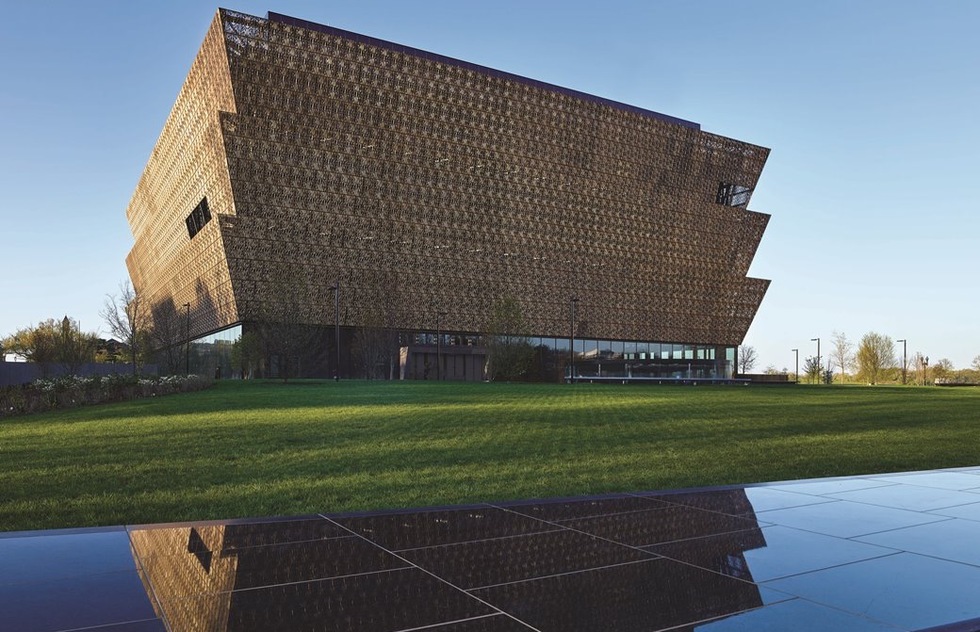A profound and essential American experience awaits you at the Smithsonian’s newest museum, which opened in 2016. Conceived as a place where visitors of all backgrounds might comprehend America’s narrative through an African-American lens, the museum succeeds on every level. History exhibits, culture galleries, and the museum’s architecture and design each express critical elements of the story.
Turns out, many, many people are interested in understanding that story, more people, in fact, than the museum can usually accommodate on any given day. So, a free timed-pass system has been instituted to control the crowds. You have two options for obtaining advance-entry passes: You can reserve them up to 30 days in advance; these timed-entry passes are released every day at 8am. Or you can try to snag same-day time-entry passes online, which go up each morning at 8:15am and last until they run out. Every visitor needs to have a timed entry ticket—even infants. You can reserve up to six tickets per reservation.
Located across from the Washington Monument, within view of the Lincoln Memorial and the White House, and next door to the National Museum of American History, the museum’s very placement nudges the visitor toward a contextual appreciation. The building belongs within this panoply, but it speaks for itself, a remarkable standout in this cool landscape of white stone structures. A three-tiered shell of 3,523 bronze-colored panels, the “corona,” sheaths the museum’s glass-walled exterior, angling outward and upward, suggesting designs found in traditional West African sculpture and headwear. The filigreed pattern of the corona mimics the ornate ironwork crafted by slaves in 19th-century New Orleans and Charleston. (As you move along inside, you will notice cutouts in the building’s bronze scrim, which allow glimpses of surrounding landmarks, including the White House, Lincoln Memorial, and Arlington Cemetery, reinforcing the museum’s emphasis on viewing the American experience through the eyes of an African American.)
When you enter the museum, you are stepping inside a 400,000-square-foot space, 60% of which lies below ground. And down is where visitors go first, to the History Galleries, or “crypts”—the heart of the experience.
The museum covers more than 500 years of history, starting in the 15th century with the transatlantic slave trade and continuing to slavery in the U.S., the Civil War, Reconstruction, segregation, the Civil Rights movement, and America since 1968. Ramps lead from one exhibit area and level to the next, creating different vantage points for viewing the artifacts and for connecting the gradual progression of events in time. This bottom-to-top touring offers a symbolic converse of that in place at the United States National Holocaust Memorial Museum, where you begin at the top floor and descend (from the rise of Hitler and Nazism to the Final Solution). Exhibits at both museums reveal history through chronological storytelling that focuses on the lives of ordinary and heroic individuals. And both museums provide areas of contemplation and reflection, where visitors can sit and take everything in, from the tragic facts to celebrations of the indomitable human spirit.
Compelling, sometimes shocking, artifacts bring the history to life. These include shackles used by an enslaved child, an early 1800s weatherboard-clad slave cabin from Edisto Island, South Carolina; Harriet Tubman’s shawl and hymn book; a vintage, open-cockpit biplane used at Tuskegee Institute to train African-American pilots during World War II; the Greensboro, North Carolina, Woolworth’s lunch counter stools occupied on a February day in 1960 by four black college students who refused to move after being denied service; and assorted documents and artifacts that capture more recent developments, from the presidency of Barack Obama to the Black Lives Matter movement.
On floors two and three above ground, “the Attic,” are exhibits that highlight African-American struggles and achievements exploring stories of place, region, and migration; how African Americans carved a way for themselves in a world that denied them opportunities; and African Americans’ contributions in sports and the military.
The fourth floor’s Arts and Culture Galleries showcase African-American contributions in music, fashion, food, theater, and the visual arts. Artifacts displayed on these floors range from the outfit that Marian Anderson wore when she sang at the Lincoln Memorial in 1939, to Chuck Berry’s red Cadillac convertible, to artworks by Romare Bearden and Elizabeth Catlett.
The story of the museum itself is worth telling, too, and it is told here on the concourse level of the museum. “A Century in the Making” reveals that a group of black Civil War veterans are said to have proposed the idea for an African-American history museum in 1915. Congress took up the cause from time to time over the ensuing decades, finally enacting the NMAAHC Act in December 2003, establishing the museum within the Smithsonian Institution. A four-firm architectural unit won the design competition in 2009, groundbreaking took place on February 22, 2012, and construction began. Meanwhile, staff, starting from scratch, were traveling around the country amassing artifacts. Today, more than half of the museum’s collection of 37,000 objects are donations.
Given the NMAAHC’s multi-layered chronicling of African-American history from its very beginnings, it is moving that President Barack Obama, the country’s first black president, was the person to cut the ribbon at its opening. But, say officials, that’s not the end of the story for African-American progress, nor for the museum. This is a living museum, and it will continue to tell the ever-evolving story of African-American history and culture, which at this particular time in America is more necessary than ever.
If you have time, stop by Sweet Home Café, the museum’s 400-capacity cafeteria serving African-American tastes rooted in regional cooking traditions: the agricultural south, Creole coast, north states, and the western range. Check before you arrive to current hours for both the museum and the café.






 About our rating system
About our rating system


